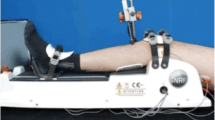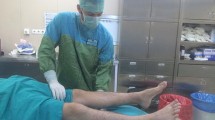Abstract
Purpose
The main goal of this study was to compare the results of the GNRB® arthrometer to those of Telos™ in the diagnosis of partial thickness tears of the anterior cruciate ligament (ACL).
Methods
A prospective study performed January–December 2011 included all patients presenting with a partial or full-thickness ACL tears without ACL reconstruction and with a healthy contralateral knee. Anterior laxity was measured in all patients by the Telos™ and GNRB® devices. This series included 139 patients, mean age 30.7 ± 9.3 years. Arthroscopic reconstruction was performed in 109 patients, 97 for complete tears and 12 single bundle reconstructions for partial thickness tears. Conservative treatment was proposed in 30 patients with a partial thickness tear. The correlation between the two devices was evaluated by the Spearman coefficient. The optimal laxity thresholds were determined with ROC curves, and the diagnostic value of the tests was assessed by the area under the curve (AUC).
Results
The differential laxities of full and partial thickness tears were significantly different with the two tests. The correlation between the results of laxity measurement with the two devices was fair, with the strongest correlation between Telos™ 250 N and GNRB® 250 N (r = 0.46, p = 0.00001). Evaluation of the AUC showed that the informative value of all tests was fair with the best results with the GNRB® 250 N: AUC = 0.89 [95 % CI 0.83–0.94]. The optimal differential laxity threshold with the GNRB® 250 N was 2.5 mm (Se = 84 %, Sp = 81 %).
Conclusion
The diagnostic value of GNRB® was better than Telos™ for ACL partial thickness tears.
Level of evidence
Diagnostic study, Level II.


Similar content being viewed by others
References
Ahldén M, Hoshino Y, Samuelsson K et al (2012) Dynamic knee laxity measurement devices. Knee Surg Sports Traumatol Arthrosc 20:621–632
Bach BR, Warren RF, Flynn WM et al (1990) Arthrometric evaluation of knees that have a torn anterior cruciate ligament. J Bone Joint Surg Am 72:1299–1306
Bak K, Scavenius M, Hansen S et al (1997) Isolated partial rupture of the anterior cruciate ligament. Long-term follow-up of 56 cases. Knee Surg Sports Traumatol Arthrosc 5:66–71
Barrack RL, Buckley SL, Bruckner JD et al (1990) Partial versus complete acute anterior cruciate ligament tears. The results of nonoperative treatment. J Bone Joint Surg Br 72:622–624
Beldame J, Mouchel S, Bertiaux S et al (2012) Anterior knee laxity measurement: comparison of passive stress radiographs Telos® and “Lerat”, and GNRB® arthrometer. Orthop Traumatol Surg Res 98:744–750
Berry J, Kramer K, Binkley J et al (1999) Error estimates in novice and expert raters for the KT-1000 arthrometer. J Orthop Sports Phys Ther 29:49–55
Branch TP, Mayr HO, Browne JE et al (2010) Instrumented examination of anterior cruciate ligament injuries: minimizing flaws of the manual clinical examination. Arthroscopy 26:997–1004
Buckley SL, Barrack RL, Alexander AH (1989) The natural history of conservatively treated partial anterior cruciate ligament tears. Am J Sports Med 17:221–225
Collette M, Courville J, Forton M, Gagnière B (2012) Objective evaluation of anterior knee laxity; comparison of the KT-1000 and GNRB® arthrometers. Knee Surg Sports Traumatol Arthrosc. doi:10.1007/s00167-011-1869-2
Colombet P, Dejour D, Panisset JC et al (2010) Current concept of partial anterior cruciate ligament ruptures. Orthop Traumatol Surg Res 96:S109–S118
Daniel DM, Stone ML, Sachs R, Malcom L (1985) Instrumented measurements of anterior knee laxity in patients with acute anterior cruciate ligament disruption. Am J Sports Med 13:401–407
DeFranco MJ, Bach BR (2009) A comprehensive review of partial anterior cruciate ligament tears. J Bone Joint Surg Am 91:198–208
Ganko A, Engebretsen L, Ozer H (2000) The rolimeter: a new arthrometer compared with the KT-1000. Knee Surg Sports Traumatol Arthrosc 8:36–39
Huber FE, Irrgang JJ, Harner C, Lephart S (1997) Intratester and intertester reliability of the KT-1000 arthrometer in the assessment of posterior laxity of the knee. Am J Sports Med 25:479–485
Jardin C, Chantelot C, Migaud H et al (1999) Low accuracy of KT-1000 versus Telos radiographic measurements to assess anterior knee laxity after ACL graft. Intra and interobserver reproducibility of KT-1000. Rev Chir Orthop Reparatrice Appar Mot 85:698–707
Lee YS, Han SH, Jo J et al (2011) Comparison of 5 different methods for measuring stress radiographs to improve reproducibility during the evaluation of knee instability. Am J Sports Med 39:1275–1281
Margheritini F, Mancini L, Mauro CS, Mariani PP (2003) Stress radiography for quantifying posterior cruciate ligament deficiency. Arthroscopy 19:706–711
Muellner T, Bugge W, Johansen S et al (2001) Inter- and intra-tester comparison of the Rolimeter knee tester: effect of tester’s experience and the examination technique. Knee Surg Sports Traumatol Arthrosc 9:302–306
Ohsawa T, Kimura M, Kobayashi Y et al (2012) Arthroscopic evaluation of preserved ligament remnant after selective anteromedial or posterolateral bundle anterior cruciate ligament reconstruction. Arthroscopy 28:807–817
Papandreou MG, Antonogiannakis E, Karabalis C, Karliaftis K (2005) Inter-rater reliability of Rolimeter measurements between anterior cruciate ligament injured and normal contra lateral knees. Knee Surg Sports Traumatol Arthrosc 13:592–597
Pugh L, Mascarenhas R, Arneja S et al (2009) Current concepts in instrumented knee-laxity testing. Am J Sports Med 37(1):199–210
Robert H, Nouveau S, Gageot S, Gagnière B (2009) A new knee arthrometer, the GNRB: experience in ACL complete and partial tears. Orthop Traumatol Surg Res 95:171–176
Schuster AJ, McNicholas MJ, Wachtl SW et al (2004) A new mechanical testing device for measuring anteroposterior knee laxity. Am J Sports Med 32:1731–1735
Solomon DH, Simel DL, Bates DW et al (2001) The rational clinical examination. Does this patient have a torn meniscus or ligament of the knee? Value of the physical examination. JAMA 286:1610–1620
Stäubli HU, Jakob RP (1991) Anterior knee motion analysis. Measurement simultaneous radiography. Am J Sports Med 19:172–177
Swets JA (1988) Measuring the accuracy of diagnosis system. Science 240:1285–1293
Author information
Authors and Affiliations
Corresponding author
Rights and permissions
About this article
Cite this article
Lefevre, N., Bohu, Y., Naouri, J.F. et al. Validity of GNRB® arthrometer compared to Telos™ in the assessment of partial anterior cruciate ligament tears. Knee Surg Sports Traumatol Arthrosc 22, 285–290 (2014). https://doi.org/10.1007/s00167-013-2384-4
Received:
Accepted:
Published:
Issue Date:
DOI: https://doi.org/10.1007/s00167-013-2384-4




